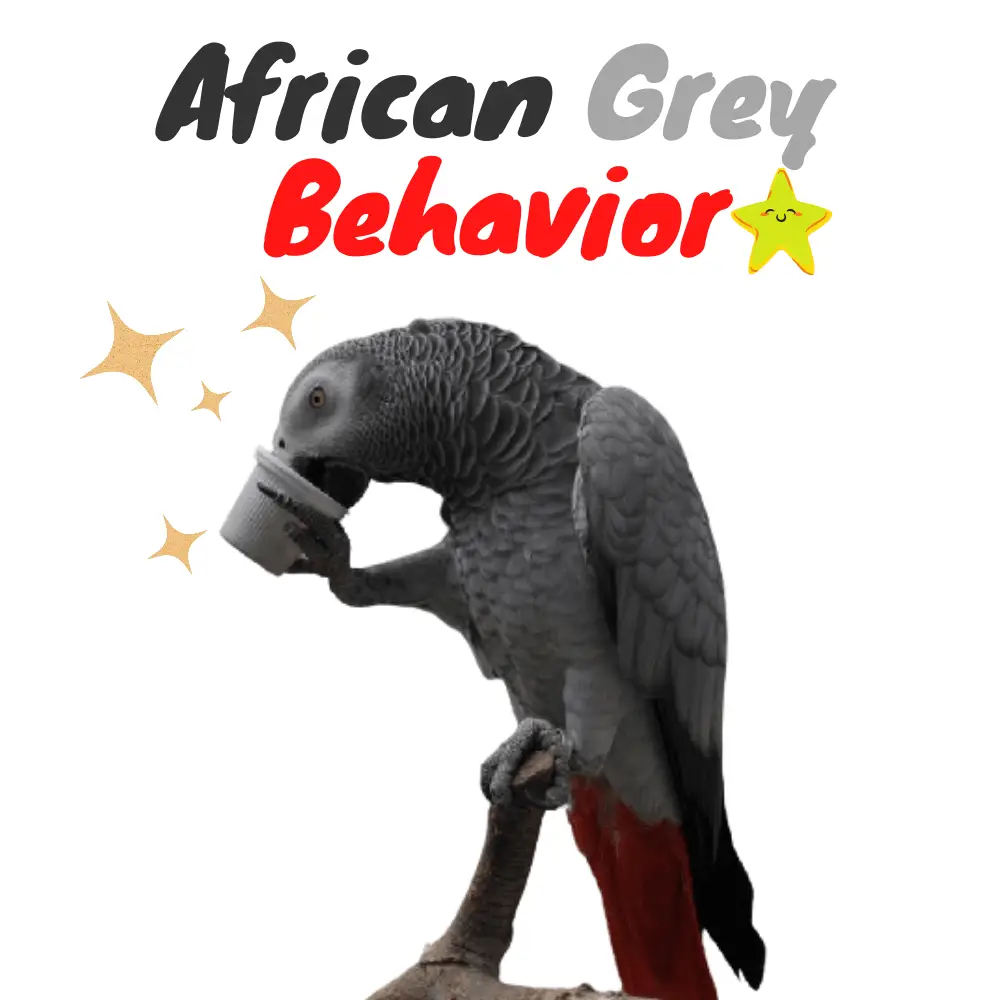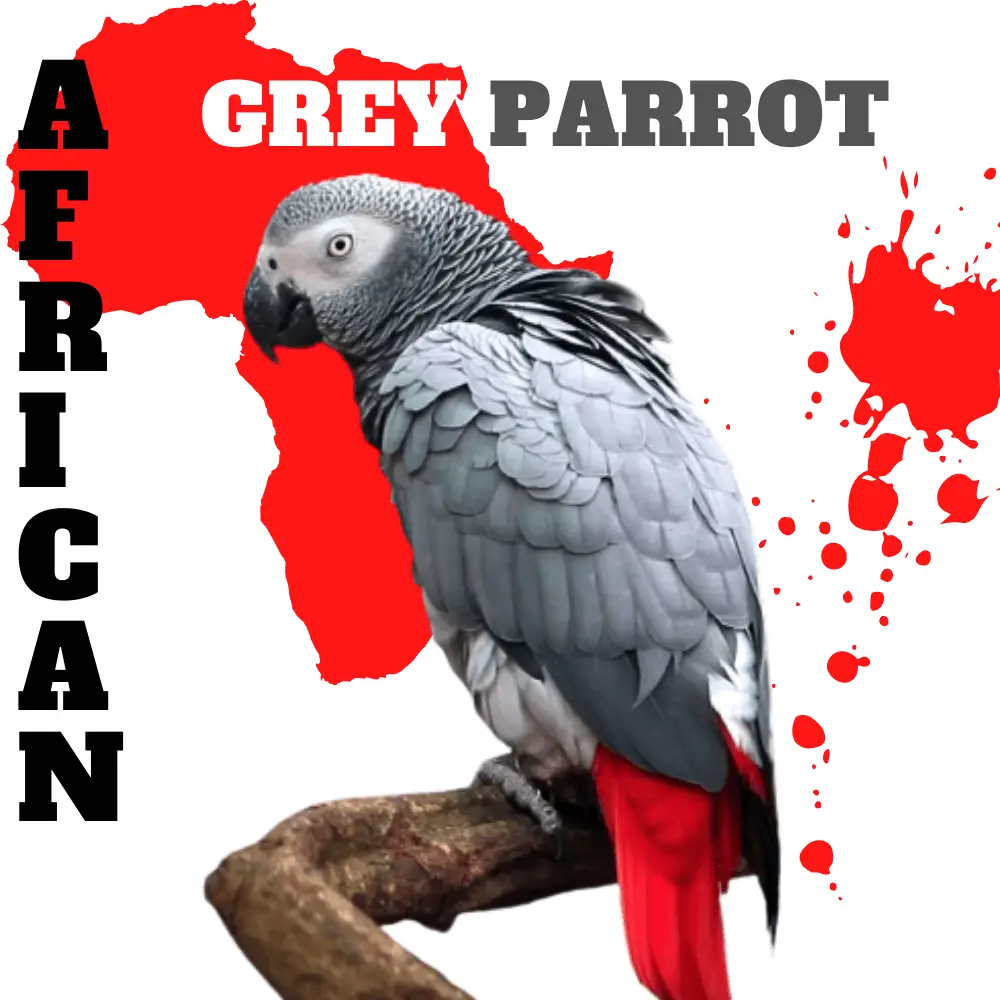
The African grey parrot Psittacus erithacus is a species of bird in the parrot family Psittacidae. It is the only species in the genus Psittacus. With a body length of approx. 33 cm and body weight of up to 450 g, it is one of the largest parrots in Africa.
Here is the most important information regarding the African parrot:
- The name of the bird: is the African parrot or the so-called African grey parrot (English: African Grey Parrot).
- Scientific Name: Psittacus erithacus.
- Family: Parrots.
- Where it is found: Tropical regions found in Africa.
The African Grey parrot is also often kept and bred in zoos and private homes in Europe and in the USA. Due to their high level of intelligence and their ability to speak, they are among the most important animal species in cognition research.
Reports and research on free-living parrot African grey, on the other hand, are rarer. They appear in paintings by European artists after European seafarers had reached the African distribution area for the first time.
African Parrot Subspecies
Today two forms of African parrots are distinguished. Firstly, the Congo grey parrot and time grey, which was described by Linnaeus in 1758 as Psittacus erithacus and occurred in Gabon.
Second, the Timneh grey parrot was described by Fraser in 1844 after its location in Timneh County, Sierra Leone, as Psittacus Timneh. There are differing views as to whether both forms should be treated as species or subspecies.
The distinction of a third subspecies ( P. e. princeps ) from the Príncipe Islands and Bioko, whose representatives are said to be larger and darker than the mainland Congo grey parrot, is now considered questionable.
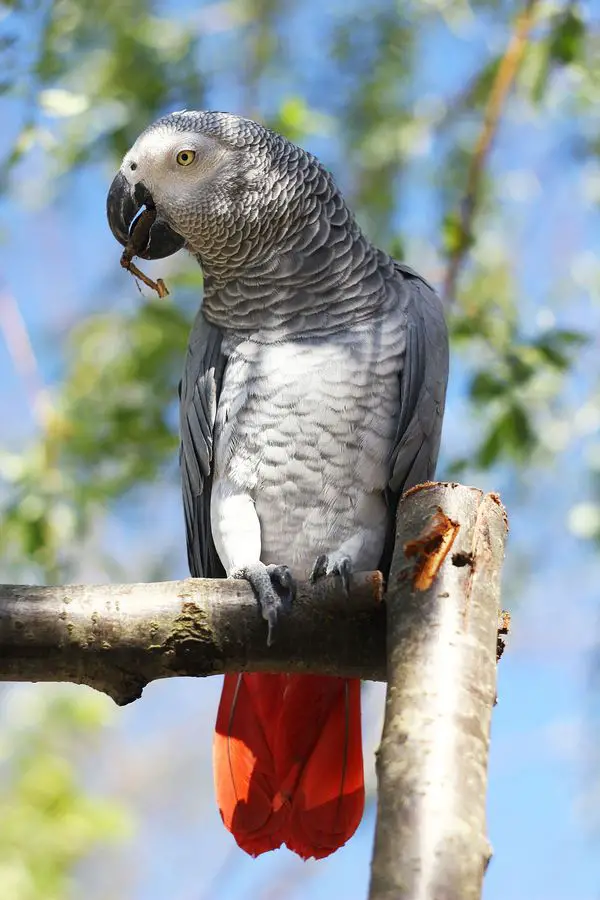
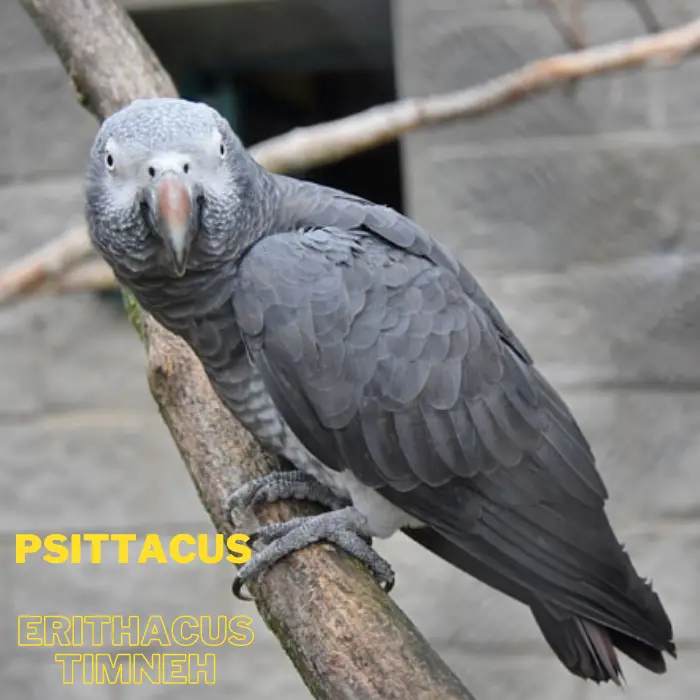
Description of species and subspecies
The African Grey parrots have an eponymous predominantly gray plumage, the face is white and featherless around the eyes, and the plumage on the head is lighter.
The cere is white, the beak is black, and the iris is yellow or white-yellow. Females are colored like males, often slightly smaller. Juveniles have a slightly brown-grey plumage on the back and wings and different tail colors.
The iris changes color from black to dark grey and gray to white-yellow after 6-8 months. The nominate form has a bright bright red tail.
Timneh Grey is slightly smaller, its tail feathers are a dirty burgundy, its upper beak is not black but a lighter brownish-pink and its plumage is a darker grey.
Depending on the region of origin, the Congo grey parrot shows differences in body size and coloration. For example, birds from Cameroon are darker grey in color than birds from the Congo.
Mutation breeding plays no role in African parrots. In the case of the so-called king grey parrots, which have numerous red feathers on their bodies and whose existence is discussed above all in shallow literature, among keepers and breeders as well as in internet forums, there is probably a pathological or diet-related deviation in the plumage coloration.
African Grey Parrot Lifespan

Information on the average and maximum age of African Grey Parrot living in the wild is not available. In captivity, the species can live up to 60 years. An age of 73 years is documented as an extreme case.
Read More About African Grey Parrot Lifespan
Distribution
The distribution area of the grey parrot: The Grey Parrot inhabits Central and West Africa and is resident throughout its range. The distribution reflects the occurrence of tropical rain forests quite accurately and extends somewhat into the area of the wet savannas at the edges of the area.
The Congo African parrot is distributed northward to southern Nigeria, Cameroon, and the Central African Republic, and eastward to western Kenya, and northwestern Tanzania.
African Grey Parrot Habitat
The grey parrot is a typical tree dweller. Its habitat includes tropical rainforests, mangroves, and wet savannas. It likes to stay on the fringes of forests towards the open countryside, where it also frequents cultivated land and gardens but avoids human settlements.
Spread
Core areas of distribution are Gabon, the Republic of the Congo, and the north and central parts of the Democratic Republic of the Congo.
Western range outposts are in southern Ghana and southeastern Côte d’Ivoire, and as the “Principe grey parrot” on the islands of Bioko (Fernando Poo), São Tomé, and Príncipe.
The Timneh grey parrot is found in southwestern Côte d’Ivoire, Sierra Leone, Liberia, and southeastern Guinea.
African Grey Parrot Diet
The African Grey parrot prefers vegetarian food such as fruits ( nuts, berries ), seeds, flowers, and buds. They are to be regarded as less specialized generalists.
The main sources of food for parrots are fruits and parts of plants that grow on trees and shrubs. African Gray Parrots are excellently adapted to life in treetops due to their climbing foot and beak used for climbing.
Plants they eat include Elaeis guineensis (African oil palm ), Kigelia pinata ( sausage tree ), Bombax sp., Ceiba sp., Dacryodes sp., tamarind Tamarindus indica, Carica papaya ( pawpaw ), Harungana sp., Combretum sp. (bushwillow),
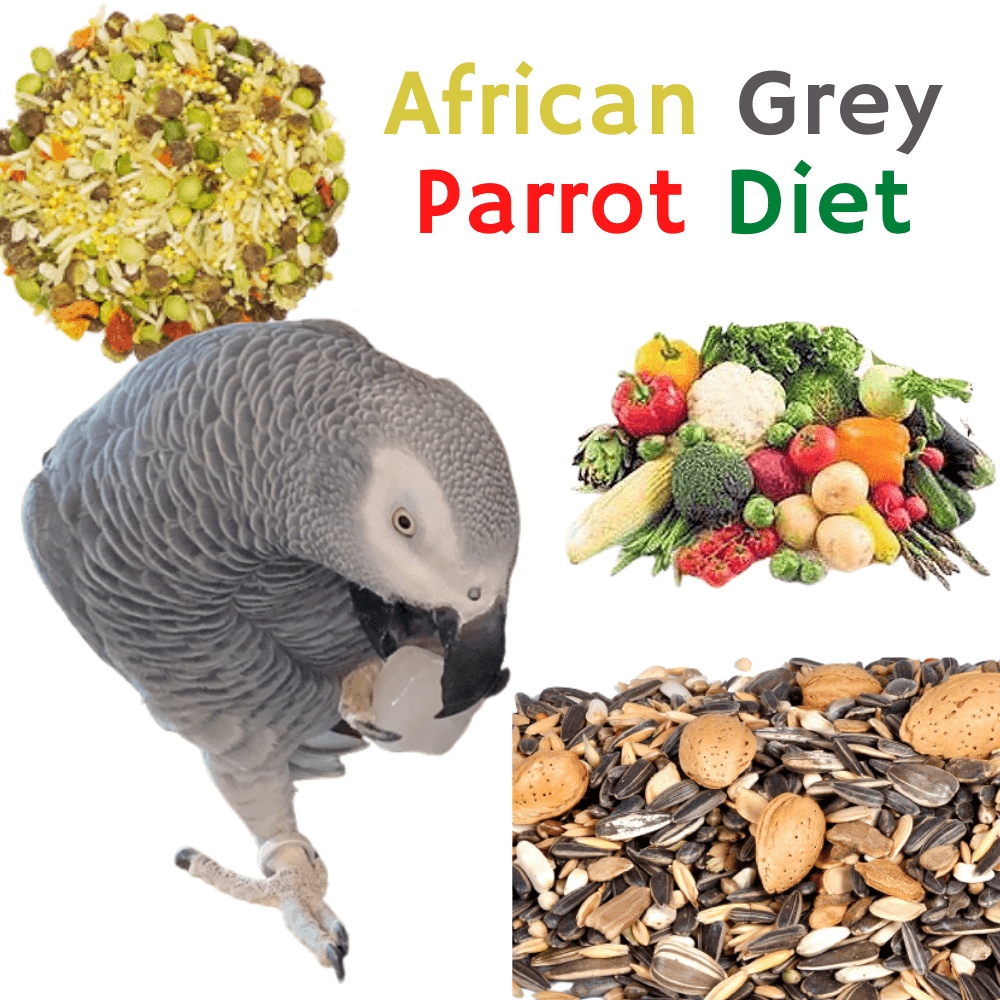
Terminalis sp., Macaranga sp., Heisteria sp., Parkia sp., Ficus sp., also Ficus sykomorus and Ficus sur, Musa sp. ( bananas ), millet, Zea mays ( corn ), Raphia sp., Prunus Africana (African Almond), Prunus sp., acacia Blighia sapida, Cola tragacanth, Celtis sp. ( hackberry ).
The main food plants probably differ regionally and seasonally according to the supply, different observers indicate different preferences, which is also clear in the older literature.
The food plants also include non-native species such as bananas or corn, which speaks for the parrot’s African grey ability to adapt.
For a subpopulation of African grey parrots, the intake of soil or clay is probably documented for mineral absorption or detoxification of food in the digestive tract.
Read More About the African Grey Parrot Diet
African Parrot parrot feeding
The African parrot is a herbivore, as it feeds in the wild mainly on nuts, fruits, and leaves of plants, In addition to flowers, bark, and invertebrates, including insects and snails, it also goes down to the ground to swallow mud and soil, to obtain nutrients and antiparasitic compounds, and when searching for food in trees it is preferable to use its beak and feet to climb between branches instead of flying.
African Grey Parrot Reproduction
The Grey parrots are likely to form a lifelong pair bond. They breed outside of the rainiest season. The breeding season changes from region to region depending on the position of the rainy season.
The bird’s nest in tree cavities, often in large dead trees. The nest cavity is padded with mold wood. The female lays 2-5 eggs and incubates them for about 4 weeks while being guarded and fed by the male. The young birds, cared for by both parents, take almost 3 months to fledge.
The reproductive performance of a pair in captivity can be very high. From 1962 to 1974, 87 young were hand-reared by a single pair in the United States. This corresponds to 7.25 pups per year. The reproduction rate in the wild is certainly lower.
Age of sexual puberty
The African parrot is a very social bird, and reproduction occurs when each husband occupies his own tree, to later choose his wife carefully, as he has a monogamous bond that lasts a lifetime, and moreover it begins to breed upon reaching sexual maturity at the age of (3-5) years.
Breeding season
The breeding season varies according to the region, but it usually coincides with the dry season, where the African parrot breeds from one to two times a year, and females lay 3 to 5 eggs, and females incubate eggs, while the male provides full food, and in fact, the incubation period takes approximately thirty days, and the young come out of the nest at the age of 12 weeks, but when the young leave the nest, the parents continue to take care of them and provide them with protection and food until they reach adulthood.
Read More about Baby African Grey Parrot
Places to Find African Grey Parrots for Sale
Here are some of the best African grey parrot breeders you can contact:
- Mika Birds Farm (MBF)
- African Grey Parrot Farm (AGPF)
- Bird Jungle
Money-Saving Tips for African Grey Owners
- Make sure to ask for affordable recommendations
- Invest in pet insurance
- Buy bird food in bulk.
- Look for deals, special offers, and discounts.
How Much Does an African Grey Parrot Cost?
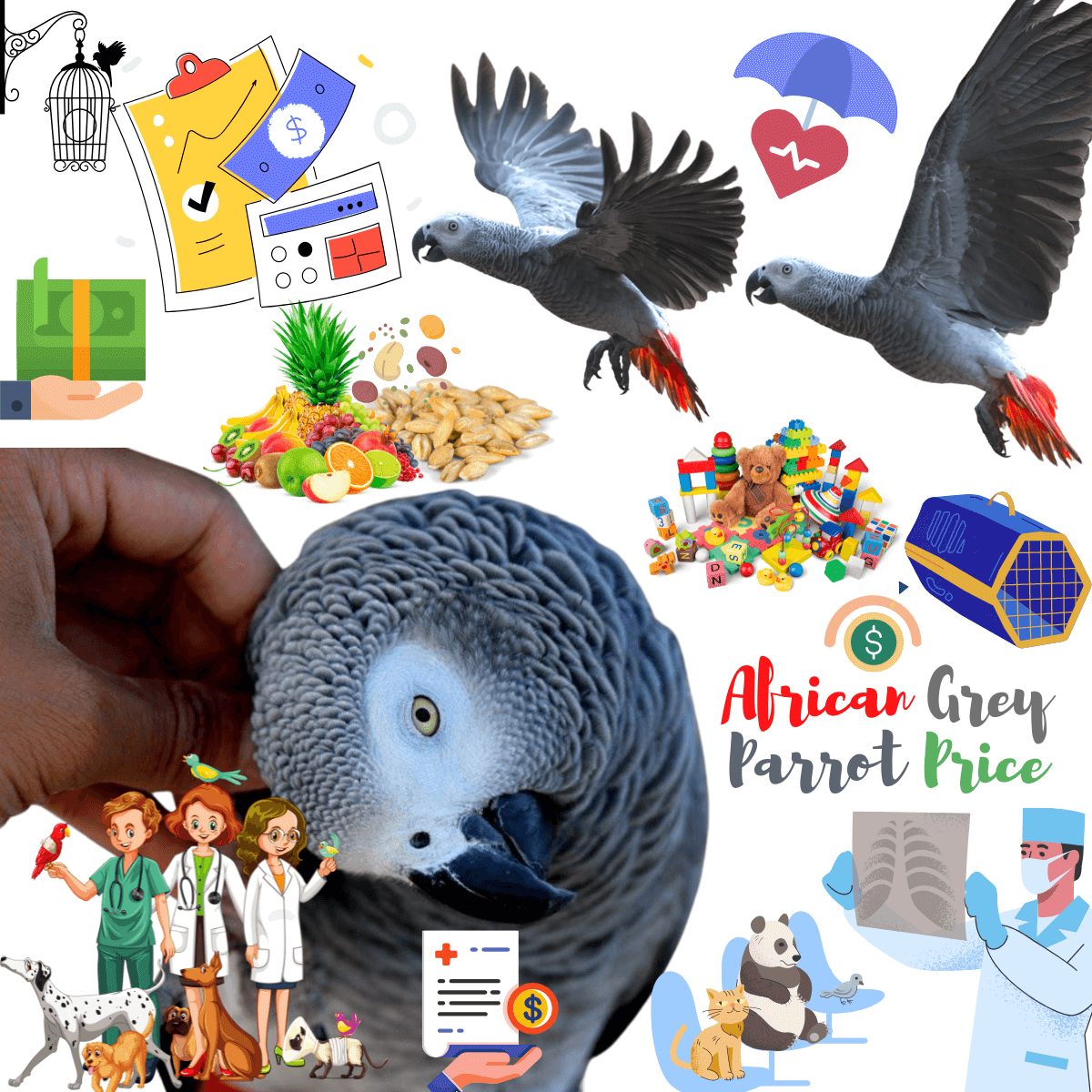
How much does an African Grey Parrot cost: Prices for a Grey Parrot are on average around $1500, but the range is fairly large, Depending on the type of African grey and where one is bought, prices vary.
| African Grey Subspecies | Price Range (USD) |
| Congo African Grey Parrot | $1,500 – $2,000 |
| Timneh African Grey Parrot | $1,800 – $4,000 |
Factors Affecting the Cost of an African Grey Parrot
- Age
- Appearance
- The Rarity of Subspecies
- Quality
- Breeder’s Reputation
- Gender
Initial Cost of Owning an African Grey Parrot
The Table presents an overview of the initial cost of owning a Parrot African Grey
| Type of Expense | Cost |
| Food and Treats | $10 – $50 |
| Mineral Supplements | $10 – $30 |
| Food and Water Bowls | $10 – $40 |
| Cage | $100 – $1,500 |
| Cage Stand | $35 – $70 |
| Cage Cover | $17 – $40 |
| Cage Liners, Bedding, and Litter | $10 – $30 |
| Cage Skirt | $7 – $12 |
| Perches and Ladders | $75 – $300 |
| Nesting Material | $5 – $15 |
| Hideaway | $9 – $17 |
| Travel Cage | $30 – $115 |
| Toys | $25 – $150 |
| Grooming Supplies | $60 – $100 |
| Cleaning Supplies | $30 – $40 |
| First Aid | $6 – $11 |
| Microchip or Leg Band | $80 – $100 |
| Total Initial Cost | $519 – $2,620 |
Read More about: The best African Grey Parrot Cage
Annual Cost of Owning an African Grey Parrot
| Type of Expense | Yearly Estimate |
| Food and Treats | $40 – $200 |
| Mineral Supplements | $40 – $120 |
| Cage Liners, Bedding, and Litter | $30 – $60 |
| Toys | $50 – $200 |
| Grooming Supplies | $120 – $200 |
| Cleaning Supplies | $60 – $80 |
| Pet Insurance | $80 – $200 |
| Routine Veterinary Visits | $185 – $200 |
| First Aid | $18 – $33 |
| Yearly Total | $623 – $1,293 |
| Average Monthly Cost | $52 – $108 |
Read More about Parrot African Grey Insurance
Other Potential Expenses
- Emergency Medical Expenses: $300 to $2,000
- Bird Pet Sitters: From $10 to $20 a day.
- Professional Grooming Services: $35 to $50 for every grooming session.
- Boarding: Between $20 and $50 per day.
- Pet Bird Breeding Expenses: From $1,000 to $5,000.
African Grey Parrot predator

Natural predators include birds of prey, protective behavior is elicited against flying black-axed eagles ( Cassinaëtus Africanus ), but not by palm vultures ( Gypohierax angolensis ),
although they have been observed successfully preying on the rather awkwardly flying African grey. Goshawks also hunt grey parrots. Nests are often robbed by monkeys and snakes
In order to limit the endangerment of wild populations, species protection laws must be observed when buying and importing animals and bred animals are to be preferred.
The super-tame hand-rearing that is often offered on the market is problematic from a zoo-biological point of view, and there can be massive problems when the animals reach sexual maturity. A market for advising pet owners has developed here. Feeding and keeping animals in captivity is not a problem today.
For every legal animal, there is a so-called CITES certificate in the European Union, i.e. a formal official document on the exception to the import and purchase bans.
In Germany, every attitude and change in the regular location of a specimen must be reported immediately to the local nature conservation authority, including its identification, i.e. regularly with the individual ring number.
The import of wild birds into the EU is currently prohibited due to bird flu prophylaxis.
African grey parrot intelligence
Individual African Grey parrots have achieved worldwide fame. The African parrot Alex (1976 to 2007), which belonged to the scientist Irene Pepperberg, became particularly well-known.
Pepperberg used him to study the cognitive abilities of African parrots, specifically their ability not only to mimic human speech but to use words in a meaningful context.
Among other things, Alex learned how to correctly name 50 objects presented to him using a special vocalization, plus seven colors and five shapes.
According to Pepperberg, he could also make simple additions and refer to nonexistent objects as nonexistent, which they call a “zero-like concept”.
However, the researcher herself admits that non-existent and zero are by no means the same thing. Alex’s abilities were unmatched by any other parrot in her group.
Joseph Haydn’s Grauparrot was able to whistle along to several melodies that Haydn composed. At parties in Haydn’s house in the Vienna suburb of Windmühle, when a toast was offered to the Emperor and a glass raised,
he is said to have whistled the melody to God preserve Franz the Emperor. After the composer’s death, the bird was finally auctioned off for the enormous price of 1,415 guilders – the equivalent of around 32,500 euros today.
Read More About :African Grey Parrot intelligence
African grey parrot History of keeping
Whether parrot grey was known in ancient Europe is questionable, as evidence for this is lacking. News of African parrots may have first reached Europe when Portuguese seafarers reached the Canary Islands
where Congo African grey is said to have existed – after 1400 or the natural African range of the parrots around 1455 Although the distribution area predated that of the Neotropical parrots, they can only be found in paintings from around 1525.

The Neotropical parrots are shown much earlier. Dürer drew the first Amazon as early as 1498, just six years after the discovery of America.
Conrad Gessner’s animal book clearly mentions an African parrot in its 1555 edition. At the beginning of the 17th century, parrot African grey was well known in Europe, since they were brought alive to Europe by seafarers.
Eleazar Albin ‘s ‘Natural history of Birds’, published between 1731 and 1738, also contains a colored illustration of the congo parrot African grey parrot.
The depictions on paintings, engravings, or watercolors from this period, some of which are very lifelike, show that African parrots were also kept more often in private hands in Europe and could therefore be known to the artists from their own observations. However, the more colorful parrot species, especially from Asia and America, dominate the paintings.
Congo African parrots are one of the few parrot species that Linne names in the 10th edition of his Systema Naturae from 1758 and are today the only parrot species that still bears the original Linnean genus name.
Two broods, which took place in France in 1799, are considered the world’s first breed. Further national breedings took place in England in 1843, in Germany in 1899, in the USA in 1931, and in Sweden in 1953.
The dates of the first breeds are later for Timneh grey parrots. The transition from random breeding to regular captive breeding occurred in the second half of the 20th century.
Breeding is no longer a problem. They are propagated in such large numbers in private hands and by commercial breeders that the need no longer has to be covered from the field. Apart from budgerigars, the African Grey is one of the most commonly kept and well-known parrot species today.
African Grey protection
A particular threat is capture and trade. The IUCN assumes that the populations are in decline. Since 2016, she has classified the species as “Vulnerable”. The causes of the decline in the species include capture for the international bird trade and increasing habitat loss.
Since 1981, the species has been subject to the Washington Convention on International Trade in Endangered Species (CITES, German WA) and since 1987 it has been specially protected under European law.
It has been listed in Appendix A of Regulation (EC) No. 338/97 ( EU Species Protection Regulation ) since February 4, 2017, and thus enjoys the highest protection status in the European Union.
Therefore, without formal approval from the competent authority, any import into the EU and any marketing in the EU is prohibited; in Germany, this is a criminal offense; this applies to living specimens as well as to parts from animals of this species or to eggs.
Owning an African grey parrot isn’t just a fun hobby it’s a very heavy commitment.





















